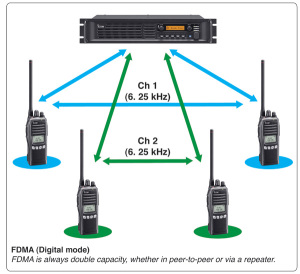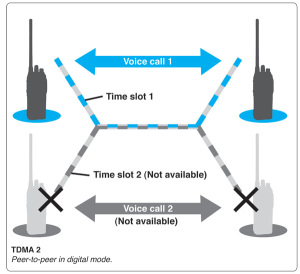Key Differences between FDMA vs. TDMA Technology
by Icom America
FDMA (Frequency Division Multiple Access) and TDMA (Time Division Multiple Access) technologies are used in P25 and in business and industrial digital radios (P25 Phase I & NXDN™ for FDMA; P25 Phase II & DMR for TDMA).
The basic difference between FDMA and TDMA is the definition of a channel and how it is used.
In FDMA, a particular bandwidth (e.g. 6.25 kHz) at a particular frequency (e.g. 150.000 MHz) is used to define a channel. This is the way channels have been allocated in analog land mobile radios (LMR) for decades. All information is contained in the channel – compressed to the smallest frequency footprint. Analog radio bandwidth has recently shrunk from 25 kHz to 12.5 kHz, which is about the limit for analog technology without seriously degrading radio voice quality. With digital technology, channel bandwidth can be compressed to a spectrum-efficient 6.25 kHz by using vocoders and error correction.
In regard to TDMA and digital technology, the 12.5 kHz channel bandwidth is maintained. The RF spectrum efficiency is achieved when two voice channels share time to create a 6.25 kHz equivalency. TDMA technology is possible only by using intelligent infrastructure to make and control the time slots.
Benefits of FDMA include the following:
Simplex Operation
FDMA allows subscriber radios to keep the efficiency of true 6.25 kHz at all times, as it is native to the basic operation of the radio. FDMA technology allows radios to continue operating with all channels available. TDMA efficiencies cannot be created with subscriber units in the field without an intelligent time synchronizing repeater that manages the time slots. TDMA technology reverts back to a single voice channel.
Although both technologies lose range in the event of a repeater failure, TDMA provides only one available channel in the 12.5 kHz spectrum – an inefficient use of the spectrum. Likewise, LMR users who want to deploy digital radio in small areas such as warehouses or campgrounds may find adding a repeater in a TDMA system an unnecessary expense.
Spectrum Efficiency
An FDMA system is a “true” 6.25 kHz channel system; TDMA is simply a 6.25 kHz channel equivalent. If 12.5 kHz is the standard for narrowband channel spacing, then FDMA achieves maximum spectral efficiency – regardless of application and with or without a repeater. All products operate at 6.25 kHz. For TDMA, increased spectral efficiency at 12.5 kHz is ONLY achieved when a repeater is synchronizing the time slots, and two users are in the same geographical area – accessing the same repeater simultaneously.
NXDN (or Icom’s IDAS™) is an FDMA technology and the only protocol to be licensed on the newly created 6.25 kHz channels assigned by the Federal Communications Commission (FCC). TDMA radios cannot be licensed for the FCC’s 6.25 channels, thus limiting the areas where this technology can be deployed. In urban areas where RF spectrum licenses are difficult to locate, it is advantageous to use FDMA technology since 6.25 kHz channel licenses are easier to find than 12.5 kHz channels.
Audio Quality
With the use of the AMBE+2 vocoder in FDMA, IDAS achieves exceptional audio quality while always operating in a true 6.25 kHz channel. Although it takes some time to get used to the digital voice, the benefits are worth it: the vocoder eliminates the background noise and static associated with analog radio signals.
Coverage
When transmitted at the same output power in identical conditions, an FDMA system’s 6.25 kHz narrower channel width should allow the signal to achieve better coverage than a 12.5 kHz TDMA system. Noise floor of any receiver is proportional to the filter bandwidth; therefore, the smaller the bandwidth, the smaller the signals that can be received. Many factors affect coverage, so specific testing would need to take place in order to make complete conclusions.
Learn more about the details of FDMA and TDMA in Icom’s 6.25 KHz FDMA Information Center white paper.




